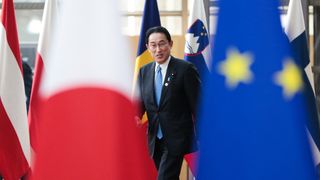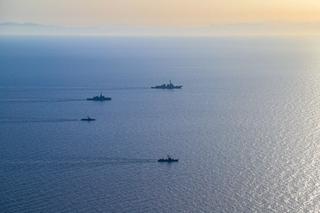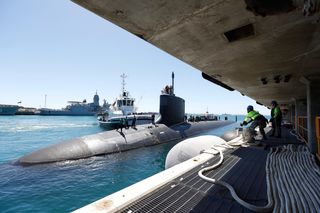At face value, the impending resignation of Japanese Prime Minister Fumio Kishida next month might worry Australian policy pundits who favour continuity. But a new leader, set to be elected on 27 September, may be empowered to launch bolder reforms on national security policy in ways that Kishida presently is not. That would ultimately benefit Japan’s regional security partners, including Australia.
Kishida’s 14 August announcement that he would not seek re-election as president of the ruling Liberal Democratic Party (LDP), the position that makes him prime minister, is not surprising. His party has suffered political funding scandals, and Japan’s economic performance is only middling. These factors saw support rates for both Kishida and the LDP plunge to a record low of in June, leading Kishida to judge that he would not have enough party support to remain as leader.
Nonetheless, he will leave office with a relatively successful foreign and defence policy record. Kishida enhanced the US–Japan alliance, revived Japan–South Korea bilateral relations and trilateral activities with the United States, and upgraded the Australia–Japan relationship to a quasi-alliance. On defence, he overhauled Japan’s security posture, championing major funding increases and force structure changes, including the procurement of long-range strike weapons, mobilising support with the adage ‘Ukraine may be the East Asia of tomorrow’.
Australia wants that trajectory to continue, so it needs Kishida’s successor to be bold on policy and, ideally, politically durable. Similar to when former prime minister Yoshihide Suga resigned in 2021, there are concerns that a return to revolving-door leadership could stall Japan’s ambitious defence reform agenda and blunt its regional foreign policy edge.
Notwithstanding that risk, Kishida’s departure could yet prove beneficial for Australia if his successor is empowered to tackle difficult policy challenges.
It’s true that the leadership change comes at a time when Japan has become increasingly central to Australian regional strategy, marked by the elevation of the strategic partnership in the 2022 Joint Declaration on Security Cooperation. Kishida implemented crucial defence and foreign policy initiatives, improving practical cooperation between the two countries. If these efforts are stalled, it may perpetuate the views of some in Australia’s policy community that Japan is incapable of moving faster or undertaking ambitious policy reform.
On the other hand, Kishida’s ability and willingness to make difficult policy trade-offs has waned significantly with his declining political fortunes in office. Some also argue that Kishida pursued security policy reforms for reasons of domestic political survival, rather than his own beliefs. Indeed, despite overseeing a revolution in Japanese national security, he may be better remembered for implementing the strategic vision and policy agenda of Shinzo Abe rather than his own. If Kishida had stayed on and failed to revive his public and party standing, his policy ambiguity and dwindling influence could have complicated complex decisions such as Japan’s potential engagement with AUKUS.
For Australia, then, what matters is the extent to which Kishida’s successor can make bold national security policy decisions, rather than simply stay the course.
Many potential candidates have substantial national security experience, including former defence minister and LDP secretary general Shigeru Ishiba, and former foreign minister and current LDP Secretary General Toshimitsu Motegi. The list also includes cabinet ministers Taro Kono, Yoshimasa Hayashi, Ken Saito, Sanae Takaichi and Yoko Kamikawa, as well as such other influential politicians as Kato Katsunobu, Shinjiro Koizumi, Takayuki Kobayashi and Shigeharu Aoyama.
Some public surveys place Ishiba at the head of the pack. But the sheer volume of potential candidates and complex LDP factional dynamics means the race is hard to pick.
On national security, conservatives like Ishiba, Takaichi and Aoyama are quite forward-leaning, arguing for bold amendments to Article 9 of the constitution and for transforming Japan’s defence-oriented policy. Ishiba, for instance, has questioned the concept of ‘minimum necessary force’ derived from the constitution’s prohibition of maintaining ‘war potential’, asking whether the minimum threshold for deterring North Korea should be the same for China.
Meanwhile, moderate realists such as Motegi, Kono, Kamikawa, Koizumi and Kobayashi would likely inherit Kishida’s foreign policy brand, balancing defence investments and enhancements to the US–Japan alliance against stable relations with China. Kono, for instance, is known both for his unusual bluntness in framing China-related security challenges and his straight talking on tricky alliance issues.
Whoever replaces Kishida, Canberra and Tokyo will keep working closely with each other and with Washington to manage the deteriorating strategic balance in the region. The key variable for Australia will be the capacity of Japan’s new leader to act swiftly and decisively on policy implementation.










